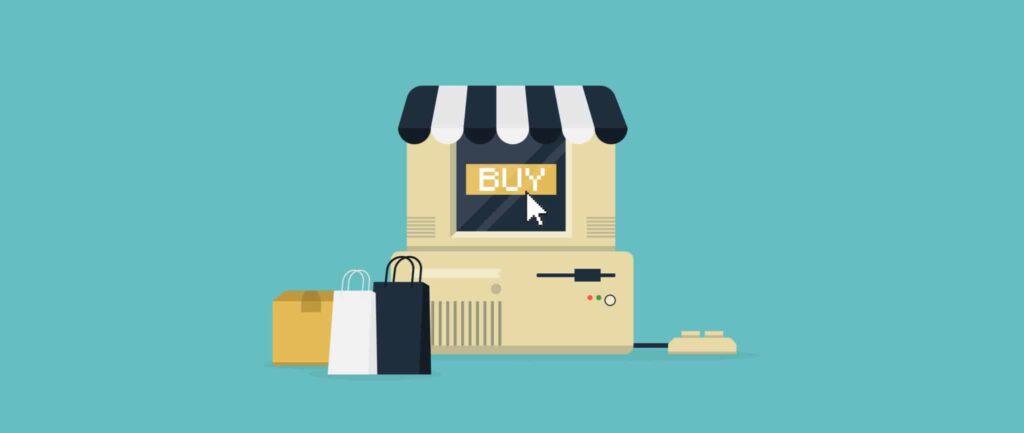These past sixty years have sure flown by, huh? Even if you weren’t around for the original moonwalk or the rise and fall of glam metal, it’s impossible to deny that our daily lives have changed forever as we march to the beat of the Digital Age.
An invention of particular note was and continues to be ecommerce, or the selling and buying of goods and services online. As any nostalgic grandparent would tell you, department stores and mail-order catalogs used to be the head honchos of retail before the World Wide Web took over… but what happened, exactly? And how? And what does this all mean? And why do socks always disappear in the washing machine?
We’re not laundry experts, but we do know a thing or two about ecommerce. As such, it would be our utmost pleasure to pass the lore of online shopping along to our readers. Sit back, grab a snack, and join us as we revisit the pixelated corridors of time.
The 1960s: Early Beginnings
Back in the day, businesses relied on primitive computer networks to conduct electronic transactions through EDI (Electronic Data Interchange), enabling them to share invoices, order forms, and shipping confirmations. EDI was created with the intention of replacing mail and fax, but it’s evolved into a technology that’s still kicking today.
Towards the tail end of the ‘60s, three key events happened in quick succession:
In 1968, The Advanced Research Projects Agency (ARPA) commissioned the world’s first routers.
In 1969, the military developed ARPANET to ensure that critical lines of communication would be maintained in the event of a nuclear attack.
Also in 1969, CompuServe, an online service provider often cited as the first ecommerce company, was founded by Dr. John R. Goltz and Jeffrey Wilkins.
The “real” invention of ecommerce would come in the next decades, but these early beginnings served as a solid foundation for the future.
The 1970s: The Start of Something New
When the ‘70s came knocking, the aforementioned advancements of the ‘60s were still largely reserved for military bases, university labs, and business offices, but the tides were gradually shifting towards a more personal approach.
In 1971, researchers established the Terminal Interface Processor (TIP) for dialing into ARPANET from individual computer terminals.
In 1972, two ambitious students from Stanford and MIT used an ARPANET account to facilitate a marijuana sale. Since the exchange was made in person, it was not technically an online transaction, but it was halfway there!
The big finale came in 1979 by way of a man named Michael Aldrich, whose name will forever be typed into the history servers as the father of ecommerce. The story goes that Michael was having a conversation with his wife about their weekly shopping trips when he had a novel idea — what if, instead of having to pick up groceries, they were conveniently delivered to the Aldrichs’ doorstep?
Inspired and invigorated, Michael connected a modified TV to a transaction-processing computer via a telephone line, thus making it possible for closed information systems to be open and shared by outside parties for secure data transmission. Michael called this “teleshopping,” now recognized by many as the bedrock of modern ecommerce.
The 1980s: Laying the Foundation
Shoulder pads, acid wash jeans, big hair, and emails… such were the hallmarks of the ‘80s (kind of).
At this point, “PC” users, who were mostly students and faculty at major research universities, were sending emails, engaging in virtual newsgroups, and exchanging files. These exciting developments were partly bolstered by CompuServe, who was continuing to introduce some of the earliest forms of interconnectivity to the public — more on them in a bit.
In 1982, ARPANET switched from using TIP (Terminal Interface Processor) to TCP/IP (Transmission Control Protocol and Internet Protocol), which is actually the same packet-switched technology that powers the internet today!
That same year, Boston Computer Exchange (another contender for the title of first ecommerce company) was launched, functioning as an online marketplace for people interested in selling and buying pre-owned computers.
Also in 1982, France launched Minitel, an online service that used a videotext terminal machine that was accessible through telephone lines. By 1997, over seven million homes had Minitel terminals.
In 1984, CompuServe came out with the Electronic Mall, which allowed its users to purchase products from approximately 110 different merchants. This online flea market wasn’t a huge hit at the time, but, as any wise business guru or self-help book would tell you, failure is a stepping stone in the journey towards success.
The 1990s: Picking Up Steam
If the ‘60s, ‘70s, and ‘80s were the ecommerce rough drafts, the ‘90s were the first edition of a New York Times bestseller.
Tim Bernes-Lee kicked things off in 1990 by building the first web server and the first web browser, which in turn led him to develop URL, HTML, and HTTP in the following years — busy guy!
In 1991, the National Science Foundation lifted its restrictions on the commercial use of its network, causing online shopping to grow exponentially. In 1995, they began charging a fee for registering domain names.
In 1994, Netscape developed SSL (Secure Socket Layers), a protocol that increased the safety of internet data transmissions. SSL was eventually succeeded by TLS (Transport Layer Security) as a way to determine whether a website can be trusted — that’s where the little lock icon in your address bar comes from!
That same year, the first encrypted online transaction was made when Phil Brandenberger of Philadelphia purchased Ten Summoner’s Tales by Sting on NetMarket. (Great choice!)
Still in 1994, Jeff Bezos launched Amazon out of his garage. Originally an online bookstore, Amazon was making waves even then by including ratings and reviews on product pages as well as introducing the concept of the “one-click” checkout.
In 1994 and 1995, First Virtual and CyberCash emerged as one of the first third-party services for processing online credit card sales.
In 1997, Dell became the first company to have their online sales reach $1M, proving that ecommerce was more than just the latest craze.
The 2000s: Striding Forward
Although ecommerce was hitting a tremendous stride, things took a turn for the worse with the dot-com bubble burst. Many technology companies — including Webvan, a pioneer of online grocery services — declared bankruptcy and ceased operations. Of course, bad times don’t last forever, and, slowly but surely, stock exchanges recovered and were stabilized by 2001.
The ‘00s saw the launch of several companies that are still big names today, like Etsy in 2005, Shopify in 2006, and BigCommerce in 2009. In 2005, Amazon introduced Amazon Prime, setting the precedent for lightning-fast shipping speeds and a higher quality of service for online shoppers.
In 2004, the Payment Card Industry Security Standards Council (PCI) formed to ensure the creation, enhancement, and implementation of security standards that protect customer account data.
The 2010s: The New Normal
Throughout the ‘10s, ecommerce matured into an ingrained part of the consumer experience, consistently gaining momentum as a hassle-free, flexible alternative to brick-and-mortar shopping.
Aside from another string of important launches — like Google Wallet in 2011, Apple Pay in 2014, and Instagram Shopping in 2017 — the ‘10s marked incredible milestones in revenue and reach. In 2019, Cyber Monday sales topped $9B, a 200% increase from 2015. By the end of the decade, Prime had acquired over 200 million subscribers. The verdict? Online shopping was officially in.
2020, 2021, and Beyond
You don’t need us to tell you that ecommerce is a pretty big deal nowadays!
In 2020, primarily due to effects of the COVID-19 pandemic, global ecommerce grew by 32.4%, accelerating projections by around five years.
By 2024, ecommerce sales are expected to overtake in-store sales.
So what’s next, you ask? The sky’s the limit! We’ll likely continue to see the perfecting and propagating of existing trends — like mobile commerce, cryptocurrency payments, AI personalization, and AR and VR — as well as new opportunities to take online shopping to the next level. What we can definitely say is that the future looks bright for ecommerce!
Questions? Feedback? We want to hear from you! Shoot us a line here.
P.S. Loved what you read? We loved writing it! Subscribe to The ShipMonk Scoop for ecommerce and logistics content that’s fresh, fun, and totally free.





